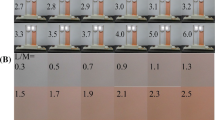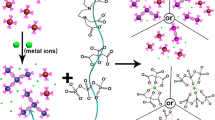Summary
The masking effects of standard masking agents (aminopolycarboxylic acids, carboxylic acids and phosphates) have been investigated in both test-tube experiments and tissue sections in order to ascertain the factors which must be considered when choosing a masking agent for the histochemical staining of a metal. The masking effectsin vitro were determined by spectrophotometry through the complexing of the dye Chrome Azurol S with aluminium, beryllium, and iron at pH 5 and 7. The effects were also examined by staining metal-containing tissue sections in a Chrome Azurol S masking agent system at the same pH values. In many cases, the masking effects observed in sections did not agree with those obtained in the test-tube experiments. This means that the published values of stability constants are not a sufficient guide for choosing a suitable masking agent for the staining of metals. The discrepancy is mainly attributable to the presence of protein in a solid state when metals are stained in sections. Therefore, in the future, consideration should be given to a metal-protein or masking agent-protein interaction using a model compound such as a chelate resin. The polyphosphates are among the most useful masking agents for metal staining in acidic solutions from a practical standpoint.
Similar content being viewed by others
References
Cheng, K. L. (1961) Increasing selectivity of analytical reactions by masking.Analyt. Chem.,33, 783–90.
Bennion, P. J. &Horobin R. W. (1974) Some effects of salts on staining: use of the Donnan Equilibrium to describe staining of tissue sections with acid and basic dyes.Histochemistry 39, 71–82.
Goldstein, D. J. (1968) On the affinity of dyes for histological substrate. InCell Structure and its Interpretation, (edited byMcGee-Russell, S. M. andRoss, K. F. A.), pp. 67–77. London: Arnold.
Horobin, R. W. (1975) Biological stains and their uses.J. Soc. Dyers Colourists 91, 4–14.
Horobin, R. W. &Bennion, P. J. (1973) The interrelation of the size and substantivity of dyes; the role of van der Waals attractions and hydrophobic bonding in biological staining.Histochemie 33, 191–204.
Hulanicki, A. (1962) Some considerations on masking effectiveness.Talanta 9, 549–57.
Marshall, P. N.&Horobin, R. W. (1973). The influence of inorganic salts when staining with preformed metal complex dyes.Histochemie 37, 299–311.
Martell, A. E. &Smith, R. M. (1974)Critical Stability Constants. Vol. 1–4. New York, London: Plenum Press.
Perrin, D. D. (1965) Multiple equilibria in assemblages of metal ions and complexing species: a model for biological systems.Science 206, 170–1.
Perrin, D. D. (1970) Masking and demasking of chemical reactions, theoretical aspects and practical applications. InChemical Analysis, Vol. 33 (edited byElving, P. J., andKolthoff, I. M.), pp. 183–204. New York: Wiley Interscience.
Perrin, D. D. &Sayce, I. G. (1967) Computer calculation of equilibrium concentrations in mixtures of metal ions and complexing species.Talanta 14, 833–42.
Sayce, I. G. (1968) Computer calculation of equilibrium constants of species present in mixtures of metal ions and complexing agents.Talanta 15, 1397–411.
Sumi, Y. (1980) Histochemical staining of cadmium with thiazolylazophenol derivatives.Histochemistry 67, 1–6.
Sumi, Y., Miyazaki, K., Tanaka, A., Muraki, T. &Suzuki, T. (1979) Differential staining of cadmium and zinc by thiazolylazophenols.Acta histochem. cytochem. 12, 460–4.
Sumi, Y., Muraki, T. &Suzuki, T. (1980) Histochemical staining of cadmium with benzothiazolylazophenol derivatives.Histochemistry 68, 231–6.
Suzuki, T., Nokubi, K. &Kato, M. (1973) Identification of beryllium on the organs.Folia Morphol. 21, 102–7.
Ueda, S. (1961) A brief survey on the properties of polyphosphates. (I) The sequesterability of sodium polyphosphate on various metallic ions (in Japanese).Kogyoyoosui 37, 32–6.
Van Duijn, P. (1976) Prospects for microscopical cytochemistry.Histochem. J. 8, 653–76.
Van Noorden, C. J. F. &Tas, J. (1981) Model film studies in enzyme histochemistry with special reference to glucose-6-phosphate dehydrogenase.Histochem. J. 13, 187–206.
Author information
Authors and Affiliations
Rights and permissions
About this article
Cite this article
Sumi, Y., Muraki, T. & Suzuki, T. The choice of a masking agent in the histochemical staining of metals. Histochem J 15, 231–238 (1983). https://doi.org/10.1007/BF01006238
Received:
Revised:
Issue Date:
DOI: https://doi.org/10.1007/BF01006238




